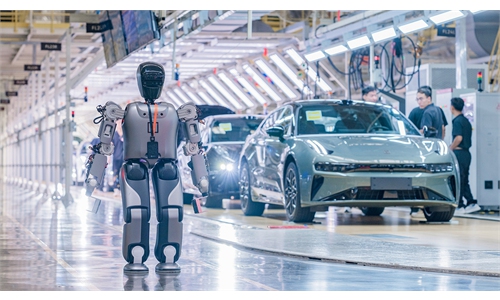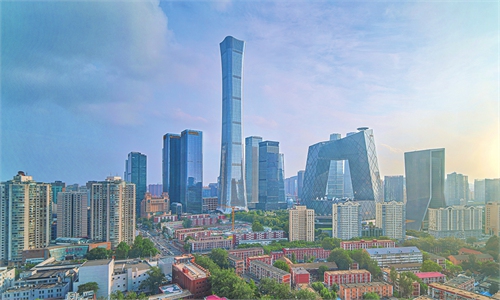
A view of the CBD area in Beijing Photo: VCG
China's technological innovation and industrial transformation calls for an increasingly educated and skilled workforce. Since the start of reform and opening-up, China's education sector has rapidly evolved, with compulsory education becoming universally available and higher education expanding, laying a solid foundation for improving the country's human resources and demographic structure.
To achieve more innovative and high-quality development, the effective utilization of human resources is of rising importance for the country.
Since the start of reform and opening-up, China has experienced rapid growth in the manufacturing industry, particularly in labor-intensive manufacturing, mainly thanks to its abundant labor force. The development model has significantly contributed to China's economic growth in the past many years.
The workforce is experiencing a significant improvement in education levels, leading to a more diverse composition of China's human capital. The changing industrial structure now requires a workforce with higher skills and education levels to meet the demands of the evolving sophistication of the economy.
China's education sector has seen marked improvement and a more diverse composition of all types of human capital, providing a necessary foundation for scientific research and technological innovation. At the same time, the supply of human resources has largely met the market demand in the country.
It is essential to enhance comprehensive education system reform and foster the across-the-board development of China's human resources. This includes implementing a top-level scientific design and early deployment of a comprehensive human resource management system.
In the new stage of development, investing in the human capital offers greater potential. The fast-paced changes in China's industrial sectors demand higher levels of specialization and tailored curricula in higher education and vocational training too. A comprehensive pathway for continuous skill development throughout the entire lifespan is essential in meeting market demands.
The current and upcoming periods are critical for advancement of China's technological innovation levels. China is shifting from relying on low labor cost advantages to focusing on productivity improvement via technological innovation. The shift highlights the need for phasing in a comprehensive human resource management mechanism in China.
The shift from China's demographic dividend to reaping the human capital dividend has yielded positive outcomes, including a notable rise in higher education enrollment rates, as well as a marked increase in the average years of education for the work force. In order to better support innovative growth, it is imperative to enhance education system reform, to bolster the system for accumulating high-quality human capital.
In order to improve the efficiency of the education sector, major abilities on the part of students including mathematical logic, creative thinking, socialization skills, teamwork and emotional intelligence are essential. It is imperative for China's basic education system to prioritize quality over quantity, with a focus on developing those critical skills and fostering versatile and innovative talent.
And, businesses are most sensitive to the changes in the broad labor market, and it is necessary to fully leverage market forces to strengthen the country's human capital.
The author is scholar at the Institute of Population and Labor Economics, CASS. bizopinion@globaltimes.com.cn



